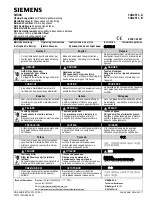
I .L . 41-891
INSTRUCTIONS
TYPE CN-33P PRIMARY NETWOR1< RELAY
c AuT 1 oN:
Before putting relays into service, re
move all blocking which may have been inserted for
the purpose of securing the parts during shipment,
make sure that all moving parts operate freely, in
spect the contacts to see that they are clean and
close properly, and operate the relay to check the
settings and electrical connections.
APPLICATION
The type CN33P relay supplies the tripping and
closing requirements of a primary disfribution net
work relay. These requirements are:
1.
Close its TRIP contacts for primary supply line
or network transformer faults.
2. Close its TRIP contacts, when the primary supply
line breaker is open, and the network is ener
gfzing the transformer. The current which flows
can be either the transformer magnetizing current
or a combination of the magnetizing current and
the primary line charging current.
3. Not close its TRIP contacts for faults within the
network.
4. Close its CLOSE contacts when the relation
between the primary supply voltage and the net
work voltage is such as to cause power to flow
from the
primary
supply line to the network.
5.
Not close its CLOSE contacts when the relation
between the feeder voltage and the network
voltage is such as to cause power to flow from
the network to the feeder.
A CNJ relay is also
needed to completely fulfill this requirement.
6. Not to close its CLOSE contacts for reverse
phase conditions; that is, when the conductor
phase sequence is not the same on each side of
the breaker.
CONSTRUCTION
The type CN-33P primary network relay, shown
in Figs. 1 & 2, is a three phase relay which oper-
NEW INFORMATION
ates on the induction principle. Its moving element
is a drum carried on a horizontal shaft which ro
tates on knife edge bearings.
Since this type of
bearing is placed at the center of the shaft, friction
is reduced to a minimum. Phosphor bronze retaining
rings encircle the ends of the drum shaft.
End
thrust is taken care of by means of flat polished
steel surfaces in the stationary bearing assembly
screws.
The ends of the drum shaft are conical,
and one end or the other makes point contact with
its associated flat steel surface depending upon the
direction of thrust.
The relay has single pole, double throw con
tacts made of pure silver. The moving contact arm
carries two spring mounted silver contacts which
are electrically one, and one flat steel spring which
extends down from the shaft.
This spring deter
mines the amount of phasing voltage n ecessary to
close the CLOSE contacts of the relay.
Counter
weights are also carried on the moving arm so that
the moving element is substantially balanced in
all positions.
The block which carries the stationary CLOSE
contacts is mounted to the left (Front View) of the
moving contact on the insulation plate through which
the drum shaft passes, and is stamped with the
letter "C". The block which carries the stationary
TRIP
contact
is
mounted to the right of the moving
contact and is stamped with the letter "T".
On the lower part of the insulation plate is
mounted another brass block with three tapped holes
in it. This block carries a small thumb screw which
acts as a stop to deflect the phasing voltage spring.
This phasing voltage spring adjuster is used to vary
the amount of phasing voltage necessary to close
the CLOSE contacts.
When the relay is completely deenergized the
moving contact is held against the TRIP stationary
contact by means of the spiral spring.
The inner
end of this spring is fastened to the moving con
tact arm and the outer end is fastened
to
a spring
adjuster which is on the front of the insulation plate.
EFFECTIVE JANUARY 1960
www
. ElectricalPartManuals
. com






























